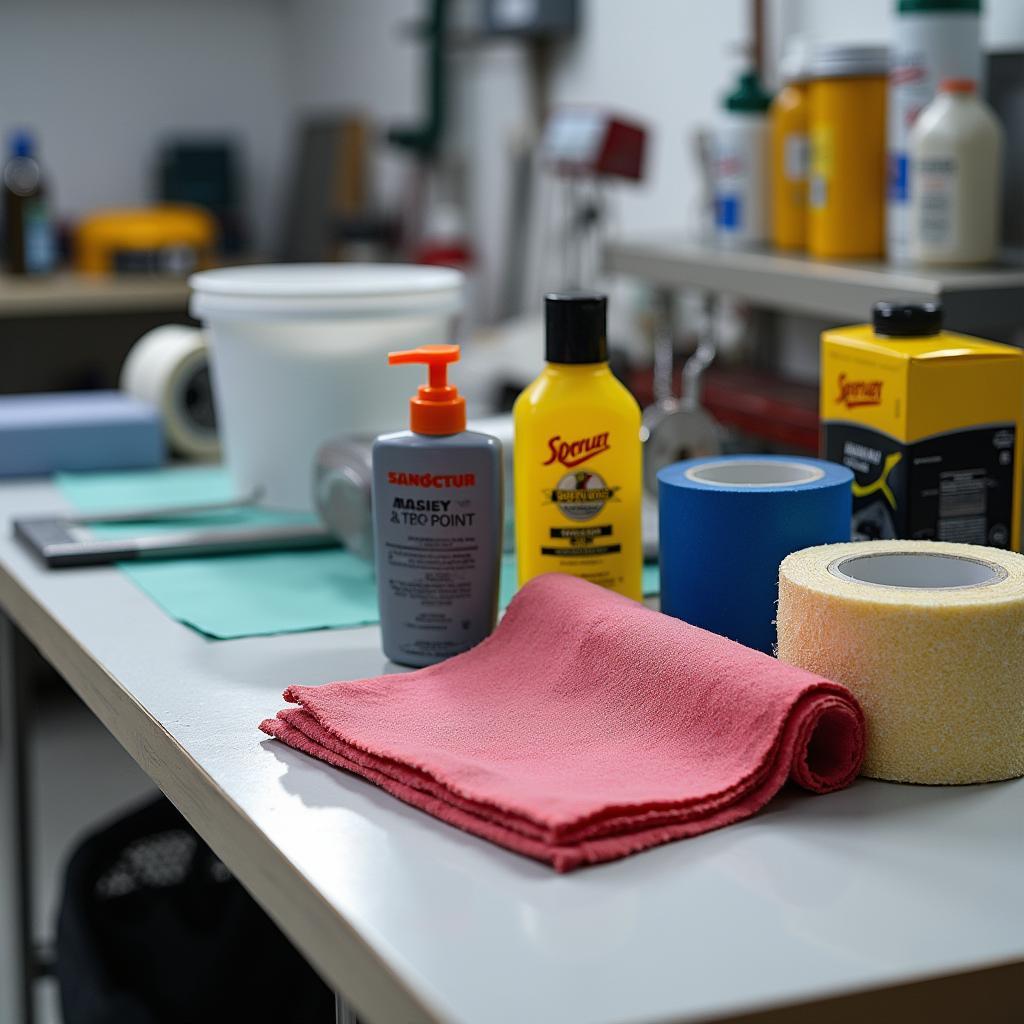Knowing how to repair paint car issues can save you a significant amount of money and keep your vehicle looking its best. Whether you’re dealing with minor scratches, unsightly chips, or sun damage, there are DIY solutions that can restore your car’s finish. This comprehensive guide will provide you with the knowledge and techniques to confidently tackle common car paint repairs.
Assessing the Damage: What Kind of Repair Do You Need?
Before diving into the repair process, it’s essential to identify the type and severity of the damage to your car’s paint.
- Scratches: Light scratches that haven’t penetrated the color layer can often be buffed out with polishing compound. Deeper scratches may require touch-up paint and clear coat.
- Chips: Paint chips expose the metal underneath, making them susceptible to rust. Repairing chips involves cleaning the area, applying primer, touch-up paint, and clear coat.
- Sun Damage: Prolonged exposure to UV rays can cause car paint to fade and oxidize. Addressing sun damage often requires polishing or even repainting the affected area.
Understanding the extent of the damage will help you determine the appropriate repair method and gather the necessary materials.
Essential Tools and Materials for DIY Car Paint Repair
Having the right tools and materials on hand is crucial for a successful car paint repair. Here’s a list of essential items:
- Cleaning Supplies: Car wash soap, microfiber cloths, rubbing alcohol, masking tape, and a bucket of water.
- Sanding Supplies: Sandpaper (2000-grit, 3000-grit), sanding block.
- Paint Supplies: Automotive primer (if necessary), touch-up paint (matching your car’s color), clear coat, rubbing compound, polishing compound.
- Application Tools: Foam applicators, paintbrushes (various sizes), tack cloth.
Step-by-Step Guide to Repairing Scratches
Step 1: Clean the Scratched Area: Wash the area thoroughly with car wash soap and water. Rinse well and dry completely with a microfiber cloth.
Step 2: Sand the Scratch (if necessary): If the scratch is deep, lightly sand the area with 2000-grit sandpaper. Sand in the direction of the scratch until it feels smooth.
Step 3: Clean Again: Remove any sanding residue with rubbing alcohol and a clean cloth.
Step 4: Apply Rubbing Compound (if necessary): For deeper scratches, use a rubbing compound to level out the area. Apply a small amount to a foam applicator and buff in circular motions.
Step 5: Apply Polishing Compound: Apply a polishing compound to a clean foam applicator and buff in circular motions. This will remove any remaining imperfections and restore shine.
Step-by-Step Guide to Repairing Paint Chips
how to repair a crack in car paint
Step 1: Clean the Chipped Area: Clean the chipped area thoroughly with rubbing alcohol and a clean cloth. Allow it to dry completely.
Step 2: Apply Primer (if necessary): If the chip is deep and exposes bare metal, apply a thin coat of automotive primer to the affected area. Allow it to dry completely.
Step 3: Apply Touch-Up Paint: Using a fine-tipped paintbrush, carefully apply a thin coat of touch-up paint to the chipped area. Allow it to dry completely.
Step 4: Apply Clear Coat: Once the touch-up paint is dry, apply a thin coat of clear coat to seal the repair. Allow it to dry completely.
Step 5: Sand and Polish (optional): If necessary, lightly sand the area with 3000-grit sandpaper once the clear coat has cured. Follow up with polishing compound to blend the repair and restore shine.
Dealing with Sun Damage and Faded Paint
Step 1: Wash and Dry the Car: Thoroughly wash and dry the car to remove any dirt or debris.
Step 2: Apply Rubbing Compound: Use a rubbing compound to remove the oxidized layer of paint. Apply a small amount to a foam applicator and work in circular motions.
Step 3: Apply Polishing Compound: Follow up with a polishing compound to restore shine and protect the paint.
“When it comes to sun damage, prevention is key. Regularly waxing your car can significantly reduce the damaging effects of UV rays,” advises John Miller, an experienced automotive paint specialist.
Tips for a Professional-Looking Finish
- Work in a well-ventilated area: Paint fumes can be harmful, so ensure proper ventilation.
- Use thin coats: Applying multiple thin coats of paint will result in a smoother finish than one thick coat.
- Allow ample drying time: Let each layer of paint and clear coat dry completely before applying the next.
- Practice patience: Car paint repair requires patience and attention to detail. Don’t rush the process.
how to repair sun damage on car paint
Conclusion
Learning how to repair paint car imperfections empowers you to maintain your vehicle’s appearance and protect its value. By following the steps and tips outlined in this guide, you can achieve professional-looking results and restore your car’s paint to its former glory. Remember, patience and attention to detail are crucial for achieving a seamless and long-lasting repair.
FAQs
1. Can I use household paint to repair car scratches?
No, using household paint on your car is not recommended. It’s not designed for automotive use and can cause more harm than good.
2. How long does it take for touch-up paint to dry?
Drying time varies depending on the type of paint and environmental conditions. In general, it’s best to allow at least 24 hours for touch-up paint to dry completely.
3. Can I wash my car after repairing a scratch?
It’s generally recommended to wait at least 72 hours after a paint repair before washing your car. This allows the paint to fully cure and harden.
4. How often should I wax my car?
Waxing your car every 3-4 months is a good rule of thumb. Regular waxing helps protect the paint from UV rays, contaminants, and minor scratches.
5. When should I consider professional car paint repair?
If you’re dealing with extensive damage, such as deep dents or large areas of peeling paint, it’s best to consult a professional auto body shop.
Still Have Questions?
Need help with a specific car repair issue? Contact our team of experts via WhatsApp at +1(641)206-8880 or email us at [email protected]. We’re available 24/7 to provide guidance and support.



